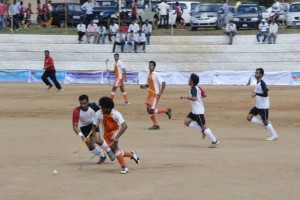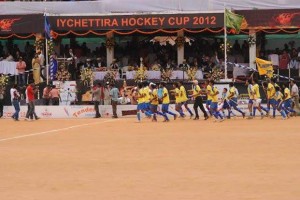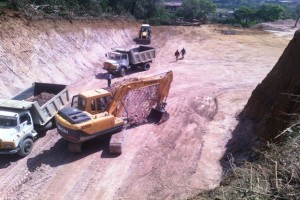
For the past two decades, Kodavas from all over the world have come back to the tiny district to take part in the annual tournament.
Kaveri Ponnapa, author of the book The Vanishing Kodavas: A Cultural Exploration of the Kodava Community, vividly remembers the frail, old lady she encountered while watching a hockey match in Coorg many years ago. “I heard her yell once during the match, ‘Avan mara khethiyandula, hockey kalchandille’ (He is chopping wood, not playing hockey),” she says.
But these are common enough scenes at the Kodava Hockey Namme, or the annual family hockey festival. Held every summer, soon after the coffee season, the Namme is a spectacle that should not be missed.
Women dressed in their stylish best, shaded from the heat by Jackie O sunglasses and broad-brimmed hats, cheer and gossip while their menfolk, some perched precariously close to the dusty field, focus intently on the brightly clad players scuttling frenziedly across it.
Children, clutching on to neon wigs too big for their small heads, weave in and out of the crowds, scrambling over the makeshift bleachers. There is no lack of food, drink or entertainment: think pork, rum, music, dance and even a few brawls on the sidelines.
“By the semifinal, these matches see almost 8,000-10,000 people congregating at the grounds,” says Sandhya Kumar, a Bengaluru-based, national award-winning filmmaker, whose 2015 documentary film, Hockey In My Blood, chronicles this very festival. “The energy from the crowds as they cheer and shout for their favourite players is incredible.”
It is that time of the year when all of Kodagu comes together; when the usual discourse revolving around coffee and politics is taken over completely by hockey. And it isn’t just the actual inhabitants of Coorg who live here all year-round, who attend this annual Namme. Kodavas from all across the country and beyond make a trip here at around that time, crossing sea and shore, to be part of this event. The month-long tournament is estimated to have almost 50,000-60,000 people attending it.

Coorg’s sporting culture
Nestled in the Western Ghats, in the south-west corner of Karnataka and bordered by Kerala on one side, the little district of Coorg, or Kodagu, is the heartland of Indian hockey. For the inhabitants of this district, which has churned out more than 50 international hockey players, the game is inextricably woven into the fabric of their everyday existence.
Despite a hectic routine, which includes visits to the estates, trips to the district’s centre and a fairly active social life, the average young planter inevitably manages to squeeze in a game of hockey at the local ground, nearly every day. And for the young men holding regular day jobs outside of Coorg—say, in Bengaluru or Mysuru—there are the matches organized by the local Kodava samaja.
Sport is simply an extension of this naturally athletic community’s culture, agrees Ponnapa. “The constant need to prove yourself physically is everywhere and hockey is an offshoot of this,” she says. “It is the nature of the place we inhabited, I think. You needed to be very fit and alert to survive here.”
The annual Namme stands testimony to this. The festival, which was started in 1997, has been going strong for exactly two decades. Open only to members of the Kodava community (anyone can attend though), matches are played between the members of different mane-pedhas, which can be loosely translated as the family name or clan name. The mane-pedha precedes the individual’s name and brings with it a unique identity.
Meet a fellow Kodava and this is the first thing that you will be asked, “Daada-re?” (which mane-pedha do you belong to?).
There are around a thousand such family units of varying sizes—some are huge, with members spread all over Coorg (and beyond), while others are restricted to tiny pockets of the district.
Kodendara, for instance, is a big family name here. Not because it is a particularly big family, but because Madappa Kariappa, India’s first field marshal, hails from it. General Subayya Thimmiah, chief of army staff from 1957 to 1961, also belonged to the same clan on his father’s side.
And while a lot of people from this community have distinguished themselves in the armed forces, their achievements in sport are not far behind either.
Other clans that have produced distinguished offspring include the Mulleras and the Anjaparavandas—former professional hockey players and Olympians Poovayya Ganesh and Bopaiah Subbaiah belonged to the two families, respectively.
“I have played in every edition of the family tournament that I could attend,” says Subbaiah, today an Indian hockey team selector. “I have only missed it when I was playing for India. Our family has won the tournament three times so far,” he adds proudly.
The Karada connection
In February, coffee processing is at its peak and the flavourful bean has taken over the lives (and land) of everyone here. Globules of ruby-red berries are drying on large, polythene sheets, spread across backyards in the district, including a large field in Karada (Virajpet) where the very first family tournament took place.
There are berries (and clothes) drying outside Pandanda Kuttappa’s little homestead in Karada. The family hockey tournament, started in 1997, was the brainchild of this sprightly 89-year-old. A former State Bank of India employee and an ex-first division referee, Kuttappa remembers attending the Asian Games in 1982, where he saw India lose to Pakistan.
“The score was 7-1,” he recalls, “Only one player, M.M. Pooviah was from Coorg. It made me realize that though we have such good players, they do not get enough opportunities.”
When he retired in 1995, he “decided to start a family hockey tournament and spent Rs15 lakh from my own pocket”, he says. Today, the budget stands at around Rs1 crore, with the money sourced from the government, sponsors and private individuals.
The first tournament, which was held in 1997 at Karada, saw 60 clans from across the region participating. “We wanted to make Karada the Sansarpur of Kodagu. Sansarpur in Punjab has so far produced 23 Olympians from its village, including the great Pargat Singh,” he smiles, adjusting his gold-framed spectacles.
The Kodava Hockey Academy, an organization set up to oversee this festival, was started soon after. Every year, a different clan or family conducts the match and it is this organization that regulates the process.
“The Kodava Hockey Academy allots the hosting rights to a family,” explains Ravi Uthappa, secretary of the Kodava Hockey Academy, adding that the family gets only one chance to host a tournament. “We have enough families battling to host the tournament. It is booked till 2020 and we have applications till 2024.”
By 1998, the number of participating teams had nearly doubled: 116 teams played the game in 1998 at the tournament hosted by the Kodira family. The popularity of the game continued to grow, reaching an all-time high in 2003 with 280 teams fighting for the Kaliyanda Cup.
“We have found a place in the Limca Book of Records as the largest field hockey tournament in India,” says Kuttappa.
“It is an extraordinary event,” says Kumar, the filmmaker, adding, “A lot is talked about leaving a legacy of sports and it is very inspiring to see a system that is making that possible within the community.”
She also believes that the tournament helps make young people economically independent. “Young boys are often spotted by Sports Authority of India (SAI) officials and end up getting a spot in the state team, which helps them ultimately get government jobs.”
Kuttappa agrees, “This tournament became a platform for youngsters to get jobs as they play with all their heart for their families. Over the years, 900-1,000 people have gotten jobs in excise, customs, banks, etc.”
Subbiah, on the other hand, is not convinced. He says that though it is certainly true that there is chance that a good player may get spotted by a SAI official at a match and may be called for a selection, “no one has got a job playing in this tournament. Only players who have gone up all the way to state and national hockey have actually gotten jobs,” he says.
He adds, however, that “there could be times when the army has come in looking to recruit players based on their hockey talent”.
In addition to this, “family hockey has created a lot of enthusiasm and inspired many people to take up the game”, he says, adding that in a few cases, matches have led to match-making. “I have heard that sometimes a good player is spotted and an alliance is fixed,” he laughs.
The Shantheyanda Cup 2016
The narrow, curved road that leads to the hill station town of Madikeri, the capital of Coorg, is flanked by tall trees with pepper vines snaking around them. Mist-swathed hills loom in the distance; lovesick cicadas compose ballads to eligible females, seduction on their minds; the omnipresent aroma of coffee merges with that of vanilla and fresh earth.
It is in these pristine, beautiful surroundings that the hockey matches will be held this year. Hosted by the Shantheyanda family, a clan dating back to the 11th century, with around 150 members, the 20th edition of the game will be held at the FMKMC College grounds in April-May.
“We started bidding three years ago and finally won it. We took over the flag in mid-May last year,” says Namrata Vikas, convener of the tournament, who married into the Shantheyanda family. Incidentally, women also participate in the tournament—they can choose to represent either their father’s family or their husband’s.
“We gave ourselves a break of about three months and then launched our logo on 9 September,” she says, adding that ground preparation is underway.

A crowd of people and one humongous earthmover toil under a searing late-morning sun at the FMKMC College grounds. The labour is necessary—the Shantheyanda family is trying to expand the size of the ground and accommodate a 400m track. “We want to leave something behind for the college, and hopefully a future tournament,” Vikas says.
The bidding process, though hugely competitive, is only the tip of the iceberg. The actual organizing of the tournament is a daunting task.
The host family needs to raise funds, prepare the fields and the galleries and stalls surrounding it, reach out to various other clans to ensure plenty of participation, manage schedules and ceremonies and garner media support. In addition to that, it has to come up with new and interesting ways to etch its name into the hearts and minds of every participant and visitor. And yes, it needs to brush up on its game.
The tournament, a surprisingly well-organized affair considering the scale, has rules that may put to shame many sports bodies in the country. Every team has a unique jersey, a family logo and flag; they must all be in proper uniform and carry the right equipment (some of which, including the goalkeeper’s kit, is provided by the hosts).
Professionalism is a vital part of every match: the referees are certified ones, strict timelines are adhered to; there are medical teams on standby and refreshments for all the players.
And the Shantheyanda family is pulling out all stops to make this year’s edition the biggest ever in the history of the tournament. “We hope to have at least 300 teams participate this year,” says Vikas Achaiah, the tournament’s director.
To ensure this, the family has sent out a flurry of invites, reached out to youth clubs and the heads of the families, and attempted to mobilize radio and local Kodava newspapers to drive home the message. “Many families who participated in earlier editions have stopped now. We are trying to find out if it is money, distance or any other reason. We will try and bring them back,” says Achaiah.
After all, “everyone makes time for hockey”, chips in Ravi Kushalappa, the tournament’s president.
With families spread so far and wide, practice sessions haven’t yet begun. “They will start (to practise as a family team) by mid-March,” says Vikas, adding that people from all over the world usually take a month’s leave from work and come down to Coorg to play.
“Earlier, if Kodavas did not get leave from their jobs to come play for a tournament, people would send a telegram saying, ‘Grandfather dead, come home immediately’,” says Kuttapa. “It was the best way to get the family members to come and play for the team back then.”
Subbiah believes the tournament does have a chance of becoming really big this year because it is now part of the Hockey India national schedule. “I am trying to bring the Hockey India League president to the game this time,” he says, adding, “Coorg hockey was dying at some point because all good hockey players were employed in places outside the district. This tournament ensures that they all return.”
More importantly, as Ponappa says, “The festival brings all the clans together. And since teamwork and community are the foundations of our society, hockey fits in here perfectly. Sport always proves to be a great binder of people.”
Comments are welcome at feedback@livemint.com
source: http://www.mintonsunday.livemint.com / LiveMint / Home> Mint on Sunday> The Small Story / by Preeti Zachariah and Sharan Poovanna / Sunday, March 06th, 2016

